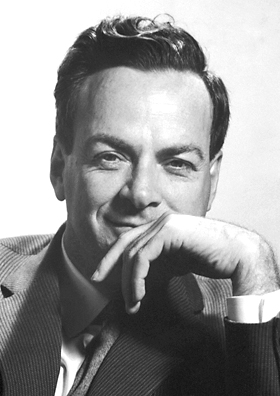Difference between revisions of "Richard Phillips Feynman"
(Partial import from https://en.wikipedia.org/w/index.php?title=Richard_Feynman&oldid=1180280953) |
|||
| (4 intermediate revisions by the same user not shown) | |||
| Line 1: | Line 1: | ||
| + | [[File:Richard Feynman Nobel.jpg|thumb|Richard Feynman, 1964.]] |
||
| + | |||
[[Richard Phillips Feynman]] (May 11, 1918 – February 15, 1988) was an American theoretical physicist, known for his work in the path integral formulation of quantum mechanics, the theory of quantum electrodynamics, the physics of the superfluidity of supercooled liquid helium, as well as his work in particle physics for which he proposed the parton model. For his contributions to the development of quantum electrodynamics, Feynman received the Nobel Prize in Physics in 1965 jointly with Julian Schwinger and Shin'ichirō Tomonaga. |
[[Richard Phillips Feynman]] (May 11, 1918 – February 15, 1988) was an American theoretical physicist, known for his work in the path integral formulation of quantum mechanics, the theory of quantum electrodynamics, the physics of the superfluidity of supercooled liquid helium, as well as his work in particle physics for which he proposed the parton model. For his contributions to the development of quantum electrodynamics, Feynman received the Nobel Prize in Physics in 1965 jointly with Julian Schwinger and Shin'ichirō Tomonaga. |
||
| Line 10: | Line 12: | ||
<blockquote> |
<blockquote> |
||
| − | I would rather have questions that can't be answered than answers that can't be questioned. |
+ | "I would rather have questions that can't be answered than answers that can't be questioned." |
<ref>https://www.goodreads.com/quotes/1134331-i-would-rather-have-questions-that-can-t-be-answered-than</ref> |
<ref>https://www.goodreads.com/quotes/1134331-i-would-rather-have-questions-that-can-t-be-answered-than</ref> |
||
</blockquote> |
</blockquote> |
||
<blockquote> |
<blockquote> |
||
| − | The first principle is that you must not fool yourself and you are the easiest person to fool. |
+ | "The first principle is that you must not fool yourself and you are the easiest person to fool." |
<ref>https://www.brainyquote.com/quotes/richard_p_feynman_137642</ref> |
<ref>https://www.brainyquote.com/quotes/richard_p_feynman_137642</ref> |
||
| + | </blockquote> |
||
| + | |||
| + | <blockquote> |
||
| + | "You cannot get educated by this self-propagating system in which people study to pass exams, and teach others to pass exams, but nobody knows anything. |
||
| + | You learn something by doing it yourself, by asking questions, by thinking, and by experimenting." |
||
</blockquote> |
</blockquote> |
||
Latest revision as of 01:49, 17 July 2025
Richard Phillips Feynman (May 11, 1918 – February 15, 1988) was an American theoretical physicist, known for his work in the path integral formulation of quantum mechanics, the theory of quantum electrodynamics, the physics of the superfluidity of supercooled liquid helium, as well as his work in particle physics for which he proposed the parton model. For his contributions to the development of quantum electrodynamics, Feynman received the Nobel Prize in Physics in 1965 jointly with Julian Schwinger and Shin'ichirō Tomonaga.
Feynman developed a widely used pictorial representation scheme for the mathematical expressions describing the behavior of subatomic particles, which later became known as Feynman diagrams. During his lifetime, Feynman became one of the best-known scientists in the world. In a 1999 poll of 130 leading physicists worldwide by the British journal Physics World, he was ranked the seventh-greatest physicist of all time.
He assisted in the development of the atomic bomb during World War II and became known to a wide public in the 1980s as a member of the Rogers Commission, the panel that investigated the Space Shuttle Challenger disaster. Along with his work in theoretical physics, Feynman has been credited with pioneering the field of quantum computing and introducing the concept of nanotechnology. He held the Richard C. Tolman professorship in theoretical physics at the California Institute of Technology.
Feynman was a keen popularizer of physics through both books and lectures, including a 1959 talk on top-down nanotechnology called There's Plenty of Room at the Bottom and the three-volume publication of his undergraduate lectures, The Feynman Lectures on Physics. Feynman also became known through his autobiographical books Surely You're Joking, Mr. Feynman! and What Do You Care What Other People Think?, and books written about him such as Tuva or Bust! by Ralph Leighton and the biography Genius: The Life and Science of Richard Feynman by James Gleick.
Quotes
"I would rather have questions that can't be answered than answers that can't be questioned." [1]
"The first principle is that you must not fool yourself and you are the easiest person to fool." [2]
"You cannot get educated by this self-propagating system in which people study to pass exams, and teach others to pass exams, but nobody knows anything. You learn something by doing it yourself, by asking questions, by thinking, and by experimenting."
Wikipedia
This article contains information imported from the English Wikipedia. In most cases the page history will have details. If you need information on the importation and have difficulty obtaining it please contact the site administrators.
Wikipedia shows a strong woke bias. Text copied over from Wikipedia can be corrected and improved.
